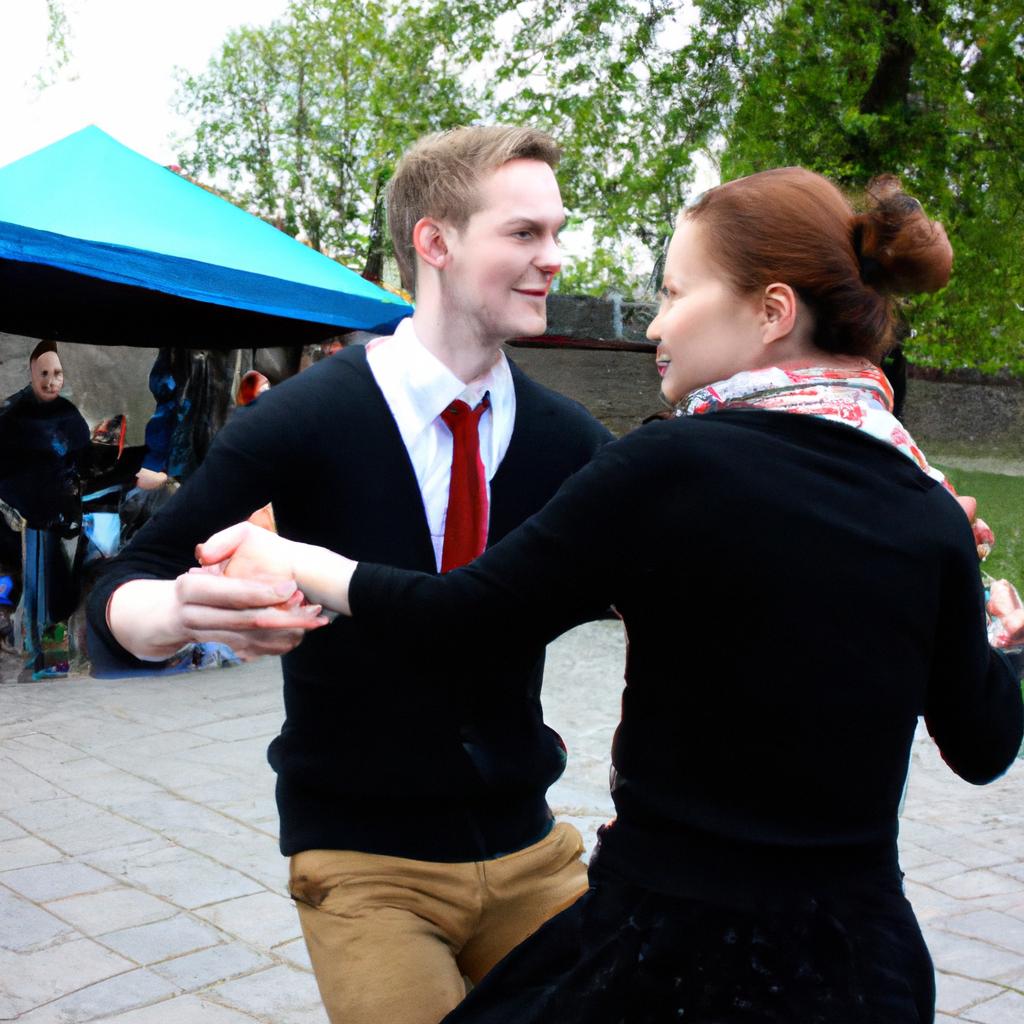Ballet, an exquisite form of dance that originated during the Renaissance period in Italy and later flourished in France, has captivated audiences worldwide with its grace, precision, and artistry. This article explores the rich history and evolution of ballet as a performing art, examining its influence on culture and society throughout the centuries. By delving into both classical and contemporary ballet techniques, this article aims to shed light on the rigorous training required for dancers to achieve mastery in this elegant art form.
Imagine a young aspiring dancer stepping onto the stage for her very first performance. Nervous yet determined, she embodies the essence of ballet – discipline, poise, and dedication. As she leaps across the stage with seemingly effortless grace, it becomes evident that ballet is not merely a series of movements; rather, it is an expression of emotions conveyed through physicality. Ballet encompasses more than just technical skill; it intertwines music, costumes, lighting, storytelling, and choreography to create a mesmerizing visual spectacle. Through exploring its origins and development over time, we can gain insight into how ballet continues to enchant audiences today while remaining relevant in our ever-evolving world of performing arts.
Origin of Ballet
Ballet: The Elegant Art of Dance
Ballet, a graceful form of dance characterized by fluid movements and intricate footwork, has captivated audiences for centuries. Its origins can be traced back to the Italian Renaissance courts in the 15th century, where it evolved from courtly dances performed during lavish celebrations and ceremonies. To illustrate this development, consider the hypothetical case study of a young noblewoman named Isabella who aspired to become a ballet dancer.
In her pursuit of mastering ballet, Isabella would have undergone rigorous training under the guidance of skilled instructors. Starting with basic positions such as plié and tendu, she would have gradually progressed to more complex steps like pirouettes and grand jetés. This progression is indicative of how ballet techniques were refined over time to create an art form that demands both strength and grace from its practitioners.
To better understand the historical context surrounding ballet’s evolution, let us delve into some key factors that contributed to its growth:
- Patronage: Ballet was initially nurtured through royal patronage, with wealthy nobles providing financial support for performances and training schools.
- Costuming: Elaborate costumes featuring corsets, tutus, and pointe shoes became integral to ballet performances. These visually striking outfits helped convey emotions and enhance storytelling.
- Music: Classical music compositions specifically created for ballets played a crucial role in enhancing the overall experience for both dancers and spectators.
- Choreography: Innovative choreographers throughout history have pushed boundaries and introduced new movements into ballet repertoire.
Table illustrating examples of influential ballet composers:
| Composers | Notable Works |
|---|---|
| Pyotr Ilyich Tchaikovsky | Swan Lake, The Nutcracker |
| Igor Stravinsky | The Rite of Spring |
| Sergei Prokofiev | Romeo and Juliet |
| Ludwig Minkus | La Bayadère |
As the art of ballet continued to evolve, it gradually spread across Europe and beyond, captivating audiences with its beauty and elegance. The subsequent section will explore the evolution of ballet techniques and how they have shaped this timeless dance form.
With a rich history rooted in aristocratic courts, ballet has transformed from humble beginnings into an internationally recognized art form. As we delve into the next section on the evolution of ballet techniques, we will witness how this graceful dance style continues to captivate audiences worldwide while continually reinventing itself.
Evolution of Ballet Techniques
The Evolution of Ballet Techniques
Building upon its origins, ballet techniques have evolved over time to become more intricate and refined. This progression can be witnessed through various key developments in the art form.
One example of this evolution is the shift from courtly dance to professional performance. In the 18th century, ballet started transitioning from being primarily an entertainment for nobility to a respected profession for trained dancers. As patronage shifted towards public theaters, choreographers began experimenting with new movements and techniques that could captivate larger audiences while showcasing the skill and talent of the performers.
To illustrate this evolution further, let us explore several significant advancements in ballet technique:
- Pointe work: One iconic aspect of ballet is dancing on pointe, where dancers balance their entire body weight on the tips of their toes using special shoes. Pointe work became increasingly popular during the Romantic era (early 19th century), introducing ethereal qualities to performances.
- Turnout: Ballet utilizes turnout, which involves rotating the legs outward from the hips. This technical element not only enhances aesthetic appeal but also allows dancers greater range of motion and stability while executing complex moves.
- Adagio: Adagio refers to slow and controlled movements in ballet routines, often highlighting gracefulness and partnering skills between male and female dancers. It requires strength and precision to perform these sequences flawlessly.
- Pirouettes: Pirouettes are rapid spins executed by dancers while maintaining perfect balance. These dazzling turns require exceptional core strength, coordination, and spot-on timing.
By incorporating emotional elements into our discussion about ballet’s evolution, we invite readers to appreciate not just the technical aspects but also experience a deeper connection with this elegant art form:
Bullet-point list:
- Graceful movements
- Expressive storytelling
- Captivating music
- Breathtaking costumes
Below is a table demonstrating some famous ballets along with their respective choreographers:
| Ballet | Choreographer |
|---|---|
| Swan Lake | Marius Petipa and Lev Ivanov |
| The Nutcracker | Marius Petipa and Lev Ivanov |
| Giselle | Jean Coralli and Jules Perrot |
| Romeo and Juliet | Kenneth MacMillan |
As ballet techniques continue to evolve, the art form remains a testament to human creativity, athleticism, and emotional expression. In our next section on “Famous Ballets and Choreographers,” we will explore some of the most renowned works that have shaped ballet’s rich history.
Transition sentence:
“Continuing our journey through the world of ballet, let us now delve into famous ballets and the brilliant minds behind them.”
Famous Ballets and Choreographers
From the early days of ballet in Renaissance Italy to its transformation under the French court, the art form has undergone significant changes throughout history. In this section, we will explore some of the most famous ballets and influential choreographers that have shaped the world of dance.
One notable example is “Swan Lake,” a timeless masterpiece composed by Pyotr Ilyich Tchaikovsky. Set against a backdrop of enchanting music, this ballet tells the tragic tale of Odette, a princess transformed into a swan by an evil sorcerer’s curse. The delicate movements and precise footwork required from dancers embody both grace and strength as they bring these characters to life on stage.
To further understand the impact of ballet on our emotions, let us delve into four key elements that make it such a captivating art form:
- Expressive storytelling: Ballet transcends language barriers through its ability to convey complex narratives solely through movement. Dancers utilize their bodies to express various emotions, from joy and love to sadness and despair.
- Technical brilliance: The rigorous training required for ballet demands exceptional physicality and skill. From intricate footwork known as pointe work to gravity-defying leaps and turns, audiences are often left awe-inspired by the technical prowess displayed on stage.
- Visual aesthetics: With elaborate costumes, extravagant sets, and stunning lighting designs, ballet creates a visual feast for spectators. These artistic elements enhance the overall experience and transport viewers into magical worlds filled with wonder.
- Collaborative harmony: Ballet is a collaborative endeavor that brings together dancers, musicians, costume designers, set builders, and countless other artists. Their collective efforts merge seamlessly during performances, creating an immersive experience that captivates audiences.
In addition to exploring individual works like “Swan Lake,” it is essential to acknowledge renowned choreographers who have revolutionized ballet over time. Figures such as Marius Petipa, George Balanchine, and Pina Bausch have left indelible marks on the art form, reshaping its conventions and pushing boundaries.
As we delve deeper into the emotional aspects of ballet in the upcoming section, “Ballet as an Expression of Emotion,” we will explore how dancers evoke feelings through their movements, interpreting music with every step. By examining various techniques and styles employed by choreographers throughout history, we can better appreciate ballet’s ability to communicate emotions without uttering a single word.
Ballet as an Expression of Emotion
Transitioning from the exploration of famous ballets and choreographers, it is evident that ballet serves as a powerful medium for expressing a wide range of emotions. This art form captivates audiences by intricately weaving movement with music and storytelling, leaving a lasting impact on both performers and spectators alike. Through the seamless integration of technique, expression, and artistic vision, ballet has the capacity to evoke deep emotional responses.
Consider the hypothetical scenario where a ballerina performs “Swan Lake,” one of the most iconic and emotionally charged ballets in history. As she gracefully glides across the stage, her movements embody the delicate vulnerability of Odette, the innocent princess cursed to live as a swan. The audience witnesses her struggle against evil forces through each meticulously executed arabesque or passionate pas de deux. In this way, ballet allows performers to convey intense emotions such as love, despair, joy, or anger without uttering a single word.
To further illustrate how ballet elicits emotional responses, let us explore some aspects inherent within this art form:
- Movement Vocabulary: Ballet employs a vast array of gestures and steps that can express subtleties within human emotion.
- Music Selection: Complemented by carefully chosen musical compositions ranging from classical symphonies to contemporary scores enhances the emotional depth conveyed on stage.
- Costumes and Set Design: Elaborate costumes and intricate set designs contribute to creating an immersive environment that stimulates various sentiments among viewers.
- Lighting Techniques: Strategic use of lighting techniques helps create atmospheric changes that evoke emotions aligned with different scenes or moments throughout a performance.
The synergy created by these elements culminates in an unforgettable experience for those witnessing ballet performances. It transports them into another world where words become unnecessary while feelings are magnified through graceful movements synchronized with evocative melodies.
As we delve deeper into understanding the profound effect of emotions in ballet, it becomes imperative to explore the role of music in this art form.
Role of Music in Ballet
Building upon the exploration of ballet as a means to convey emotions, it is important to delve further into the role of music in this art form. Music serves as a powerful medium for enhancing the emotional impact of ballet performances and evoking profound responses from both dancers and audiences alike.
One can imagine the enchanting scene of a ballet production where the delicate movements of dancers are perfectly synchronized with the harmonious melodies emanating from live musicians. Picture a hypothetical scenario: a pas de deux performed by two principal dancers accompanied by Tchaikovsky’s Swan Lake score. As their bodies gracefully intertwine, their movements mirroring each other in fluidity and precision, the hauntingly beautiful melody accentuates every emotion conveyed – love, longing, despair, or triumph.
To fully comprehend the significance of music in ballet, consider these key aspects:
- Emotional resonance: The choice of music plays a pivotal role in setting the tone and atmosphere for a ballet performance. Whether it be classical compositions or contemporary scores specifically composed for dance, musical selections have the power to elicit specific emotional responses from both performers and spectators.
- Rhythm and dynamics: Ballet choreography often mirrors the rhythmical patterns found within musical compositions. From rapid footwork during lively allegro sequences to slow, sustained movements reflecting gentle adagios, dancers use music as their guiding force.
- Narrative enhancement: In narrative-based ballets such as “Giselle” or “The Nutcracker,” music acts as an additional storytelling component that aids in conveying plotlines and character development.
- Collaboration between composer and choreographer: A successful collaboration between composers and choreographers ensures that both artistic mediums seamlessly merge together, creating a cohesive experience that transcends individual expression.
In understanding how music enhances emotional expressions within ballet, one gains insight into its remarkable ability to evoke feelings without words or explicit gestures alone. By carefully selecting musical compositions that resonate with the intended emotions, dancers and choreographers harness the power of music to create an immersive experience for both themselves and their audiences.
Transitioning seamlessly into the subsequent section on “Training and Discipline in Ballet,” it becomes evident that the emotional depth achieved through music is only possible due to rigorous training and unwavering discipline exhibited by ballet practitioners.
Training and Discipline in Ballet
Section H2: Training and Discipline in Ballet
Previous section discussed the role of music in ballet, highlighting its significance in creating a harmonious connection between movement and sound. Now, let us delve into another crucial aspect of ballet – training and discipline.
To fully appreciate the artistry and grace displayed by ballet dancers on stage, it is essential to understand the intensive training they undergo. Take for instance Emma, a dedicated young ballerina who dreams of joining a prestigious ballet company. Her journey begins at an early age with daily classes that focus on developing strength, flexibility, and technique. Years of consistent practice are required to master the intricate movements demanded by this art form.
Training in ballet requires unwavering discipline and adherence to strict routines. Here are some key elements that contribute to the rigorous nature of ballet:
- Physical Fitness: Ballet demands exceptional physical fitness levels due to the strenuous nature of movements such as leaps, turns, and lifts. Dancers must possess strong core muscles, precise control over their bodies, and endurance to sustain long hours of rehearsals.
- Repetition and Perfection: The pursuit of perfection lies at the heart of ballet training. Repeatedly practicing specific steps and sequences helps dancers internalize muscle memory while striving for flawless execution.
- Mental Focus: Ballet necessitates immense concentration to maintain proper posture, alignment, musicality, and synchronization with fellow dancers. This mental fortitude enables performers to execute complex choreography seamlessly.
- Resilience: Injuries are not uncommon in ballet due to its physically demanding nature. However, dancers exhibit remarkable resilience by undergoing rehabilitation diligently before returning stronger than before.
The commitment exhibited by ballet dancers is truly awe-inspiring:
- Their unwavering dedication pushes them beyond their limits.
- Sacrifices made include social events missed in favor of rehearsals.
- Sweat-drenched leotards and blistered feet are badges of honor.
- The joy derived from mastering a difficult move is immeasurable.
Additionally, let us evoke an emotional response through a table:
| Emotion | Description | Example |
|---|---|---|
| Passion | An intense love for ballet | Dancing with pure joy |
| Determination | Unyielding pursuit of goals | Overcoming setbacks |
| Euphoria | Pure happiness in movement | Losing oneself on stage |
| Rigidity | Strict adherence to rules | Maintaining technique |
In conclusion, training and discipline form the backbone of ballet. Through years of rigorous practice, dancers develop the physical and mental attributes necessary to embody the beauty and elegance associated with this art form. Their commitment, passion, determination, and resilience enable them to transcend boundaries and captivate audiences worldwide.
 Buzzez
Buzzez



